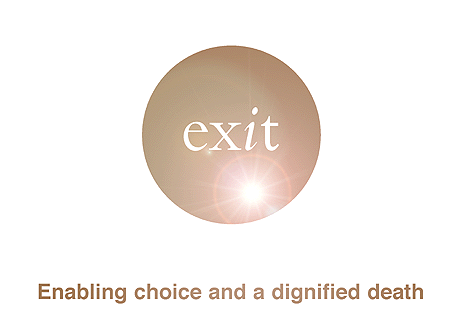 There are two fairly distinct groups of people who consider suicide, or do end their life by suicide – the first is those who very regrettably feel unable to bear what essentially is, or should be, a temporary trauma – no money, no girlfriend, terrible news, and so on (or some other type of deep depression). The second is that group of adults thinking rationally and who like to be in control of all aspects of their own life where possible and, when faced with the prospect of suffering that is neither temporary no relievable, want to decide the manner and timing of their own departure from life.
There are two fairly distinct groups of people who consider suicide, or do end their life by suicide – the first is those who very regrettably feel unable to bear what essentially is, or should be, a temporary trauma – no money, no girlfriend, terrible news, and so on (or some other type of deep depression). The second is that group of adults thinking rationally and who like to be in control of all aspects of their own life where possible and, when faced with the prospect of suffering that is neither temporary no relievable, want to decide the manner and timing of their own departure from life.
This organisation takes both groups very seriously. Empowering the second group with the knowledge often gives them the courage to live longer – a fact we have known for many years but which has also recently been commented on by a leading news magazine. At the same time, suicide prevention/intervention for the first group is equally important. Their true will is to live. But what we also know is that, if the country makes one means of suicide less available, the overall suicide rate is not affected. Desperate, suicidal people just use a different means.
This does not deter some suicide prevention groups, who seem to think that banning the means will be an answer. We don’t agree, but we do feel that knowledge of the less desirable consequences of some methods may encourage people to think twice, to gain a breathing space where they can maybe get a new perspective. For the terminally ill – those who have already explored all the palliative options and found them lacking – this will generally not be an issue.
What we don’t do is give specific instructions on our websites. Some studies have suggested that having instant access to information might encourage suicide. We find the evidence on this inconclusive, but we prefer to be safe, knowing that persons seeking self-deliverance will generally both choose sensible methods and spend the time needed to read a book on the subject, making sure they do not incur further unnecessary anguish and or self-inflicted pain.
In Five Last Acts II, we look at the most effective and painless methods of self-deliverance and go into considerable detail (with step by step diagrams) on the nuts and bolts. We are not going to do that here. The information is easily available online (sadly) but not here. Everyone knows (or can very easily find) the basics through newspaper accounts of persons who have ended their lives (for whatever reason) using helium or household chemicals. But this blog entry has two objectives:
1) To comment briefly on some of the methods most accepted by ‘right-to-die’ societies, for those already familiar with such literature, and
2) Hopefully to dissuade persons thinking of using household chemicals or other noxious methods.
We are not here to tell or persuade anyone what to do or not do. That is up to the individual to decide for him or herself. We hope people only choose wisely.
Helium is the method that is most unanimously favoured by the four main self-deliverance organisations worldwide. It requires a little preparation but is straightforward and painless. Important: this page is now several years old. For our updated information on helium please see more recent blogs, for instance here and here. This especially important for persons living in North & South America and in Australia.
Compression is an emergency method that can be used with no special equipment, for instance, if one is confined to hospital. Although very simple in essence, at self-deliverance workshops only about half to two-thirds of participants were able to understand and apply it correctly in dress-rehearsals.
Drugs. Many people think that taking a large overdose of whatever sleeping pills or tranquillizers they happen to have will be fatal. This is far from being correct. Most people attempting suicide in this manner simply wake up again, putting themselves through a lot of misery for nothing. A ‘drugs alone’ option involves either very careful planning with specific combinations of drugs or else getting barbiturates from developing countries (barbiturates are an older, very powerful sleeping drug, that have largely been removed from the market in the West – it is how Marilyn Monroe died). Obtaining barbiturates in such a manner risks imprisonment as they are classed as highly controlled narcotics.
Plastic bags and sleeping tablets. Before the days of helium and hydrogen sulphide suicides, this is the suicide option that most people will remember from the newspaper accounts. While it is the ‘traditional’ self-deliverance method, many people failed, due to incorrect application.
Other methods. These, the last selection of the “Five Acts” options that are detailed in great depth in our literature, covers methods that might be possible for some people but not others. The main one is starvation from stopping eating and drinking. Contrary to popular belief, this needs considerable preparation and expert all-round support. It is a very dangerous method to attempt otherwise and can lead to horrific death. With suitable advance preparation and nursing support it can be a peaceful option for suitable individuals. It is the cultural and lifestyle choice for end-of-life in Jain some communities to this day. Two “popular” methods deserve some mention, both originating (in their present form) from Japan. The first is carbon monoxide poisoning. People in the West used to use this way years ago. It was the “car in the garage and engine running” scenario. Now, the law requires cars are fitted with catalytic converters that remove most carbon monoxide. But the big danger of carbon monoxide poisoning is that if it goes wrong – and there are many possibilities for it to go wrong – the person is left brain-damaged. The more modern version involves charcoal burners but carries similar risks and for that reason may be best avoided. The other method – that you will have read about in the newspapers and on this website – is mixing household chemicals to produce hydrogen sulphide. This seems to have grown apace as a copycat suicide method, especially in America, but is nonetheless quite horrific. If the person is very lucky, death is almost instantaneous (as promised by amateur websites). If not, the person dies as the gas burns away their lungs and they choke. Inhaling the gas in an enclosed space (in an attempt to get enough of it and quickly enough) leaves emergency personnel at risk. Many have been hospitalised, even where warning notices have been left. Hydrogen sulphide being a heavy gas that does not disperse easily, passers-by or people in the neighbourhood are also put at risk.
It is often said that most depression can be successfully treated with modern drugs. Such medicines are prescribed millions of times around the world. But how can a pill help you if you have no money, a broken relationship, or no home? These are real questions that have to be faced. Medicine is not the same as having a job. But what they often can do is give people a breathing space, to take off some of the mental-emotional pressure. Where one day there appears to be no hope, a little later, after successful treatment, a person genuinely realises there are other possibilities open. If you are feeling depressed and suicidal, it really is worth chatting in confidence to your doctor. In fact, just chatting to someone. Talking often makes a difference. And sometimes, readjusting the chemical balance that makes things look so black allows rational options to appear – ones that are at least worthy of consideration.
For persons facing a terminal illness, the types of mental challenges are rather different. As death approaches, the choices for action, our power of making and implementing decisions, often becomes less. Knowing – not guessing, but knowing – having the safe and secure knowledge about the things mentioned here, can often restore a sense of power and hope. No-one throws away life easily – the will to live is strong. But if my prognosis was to die today in a peaceful and dignified way by my own hand, or suffer until the weekend with unendurable pain, then it is nice to know that I could put my choice into action. Knowledge is often power. So while reading the book (or several books) on self-deliverance can make you forewarned and forearmed, don’t forget the other types of knowledge you need to acquire. A deep investigation of the likely course of your disease and all the palliative care options that can be obtained. The best pain control and the limits of that pain control (often better pain-control is available than that which is offered, so make a fuss.) And, if you are facing a long illness that involves a major change of lifestyle – say in a wheelchair or bed-bound – talk to a variety of people – those in a similar situation if possible – and maybe understand different ways of looking at things.
We hope that no-one reading this will feel they have to take their own life. But if, after everything we say, you feel it is the only option, then we hope you achieve your goal with less suffering and not more.
Five Last Acts II is available from Amazon websites in the U.K., U.S.A., Japan, Germany, Spain, France and Italy. Other retailers may also be able to order it for you.







How can I get helium tablets here in New Delhi, India.. There must be prescription required but I don’t have that and I’m in terribly in need of that.. Please advise.
LikeLike
You must know if you read this Blog that we do not offer one-to-one advice on suicide or in any other way work outside the law. Helium is a gas – it doesn’t come in tablets. If it did, it would be an amazing feat of science. However if you are looking for helium gas that can also be a problem in India as the purity of ‘balloon gas’ is not reliable. I do think you maybe need to look into the subject a little more calmly deeply and consider all the options.
LikeLike
Why no mention of guns – you based in the UK? Still the most straightforward method imo.
LikeLike
Guns are covered in the most recent edition of The Exit Path and also in our members’ print magazine.
LikeLike
It is so comforting to know that there are understanding sites such as this one, that do not try to force life on those of us who do not want it.
LikeLike
In my following comment, I am going to assume “there are many possibilities for it to go wrong” refers to the use of carbon monoxide poisoning and query what evidence there is for this statement. In the 40’s & 50’s when people used to commit suicide by putting their heads in their gas oven it seemed to pretty effective. Likewise you frequently hear media accounts of people dying (unintentionally) in canal boats, apartments & even tents from CO produced by badly maintained gas equipment or charcoal barbecues but I’ve not come across one that says X or Y was left brain-damaged because of this. Providing the source of carbon monoxide is reliable the person either wakes up dizzy / with headache due to lack of oxygen reaching the brain and gets out or doesn’t wake up and ends up dead. The big risk, as in all cases of intentional suicide, seems to me to be the possibility of ‘being discovered’ while the attempt is being made. Comments welcome.
LikeLike
Firstly, I would like to thank Mr Edwards for bringing to our attention a serious typo in the article which, thanks to his vigilance, has now been corrected.
With respect to the incidence of carbon monoxide failures and the evidence of brain damage in cases of failures, it is not the practice of the Blog to list evidence simply due to the very large nature of such evidence (for all methods, not just carbon monoxide). The technical explanations can be found in our publications, particularly The Exit Path, where the relevant chapter includes numerous references of supporting evidence for this method. To list just one of them – Henry C et al, Myocardial Injury and Long-term Mortality Following Moderate to Severe Carbon Monoxide Poisoning, JAMA. 2006;295:398-402 – but you can also ascertain this particular information from many good standard reference works on toxicology. In moderate carbon monoxide poisoning, the brain can be starved of oxygen, not long enough to cause death, but long enough to cause damage to the brain. We also had particular confirmation of this when an elderly lady at one of our workshops disclosed an attempted suicide in her youth with carbon monoxide which, although not leaving her incapacitated, had left her with permanent cognitive problems. With short-term exposure, yes the person might just wake up with a headache. With long-term exposure of sufficient concentration, death occurs. It is with medium-length exposure, or exposure with an insufficient concentration of carbon monoxide, that permanent injury without death is a severe possibility. (Brain damage being just one of the types of injury.) I hope this answers questions, but for more information, do please see our publications.
LikeLike
A former neighbor (and very good plumber) tried to kill himself two decades ago after his wife announced her firm intention to divorce him. His method of choice was carbon monoxide, car exhaust running in sealed garage.
I don’t recall what the failure was, but he was left with severe brain damage (not “vegetable” but not far from). Last I heard he was institutionalized incapacitated and if he hasn’t died from some complication he probably still is, poor soul. I made a permanent note of this tragedy (however you want to interpret this) and I can attest to the absolute certainty of the risks of “not quite there” carbon monoxide poisoning.
LikeLike
Yes, this is sadly not uncommon and a reason we warn against it in the literature (as do all responsible authors). It was a method used more often before catalytic convertors were fitted to cars, but even then there were sometimes failures if the car engine stalled. Whether rational self-euthanasia or attempted suicide due to emotional trauma, it is unfortunate that many people feel it is “a simple matter” and then follow an idea that they once saw in the newspapers. For such an important event, it makes sense to look into it for accurate knowledge, far in advance when one is healthy and untroubled, just as one might do with life assurance. Most people will never use that knowledge, but it puts their mind at rest. Accepting that we are mortal and knowing one has control over the terms of one’s Exit, is life-empowering.
LikeLike